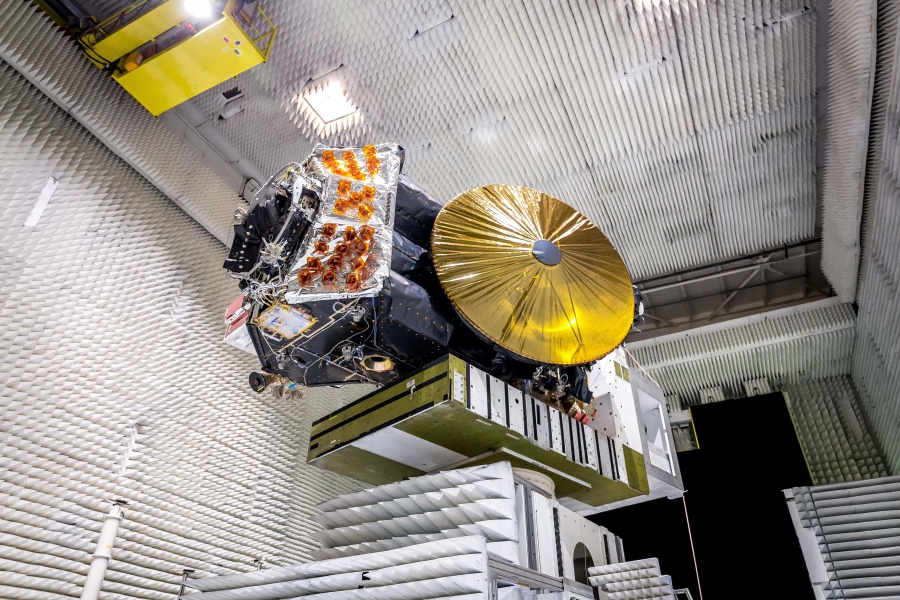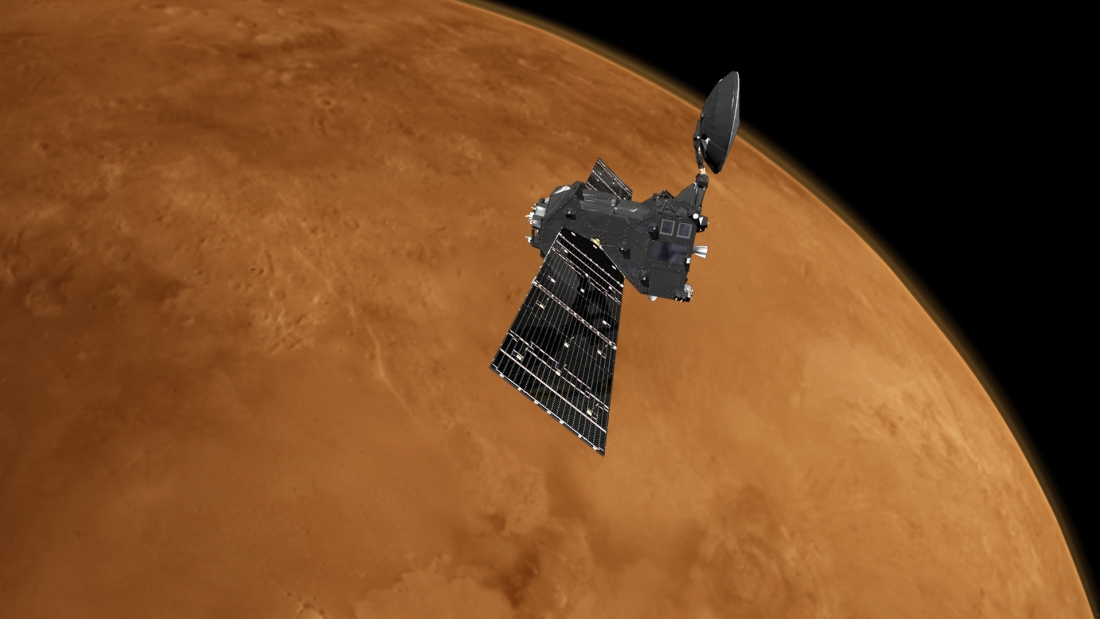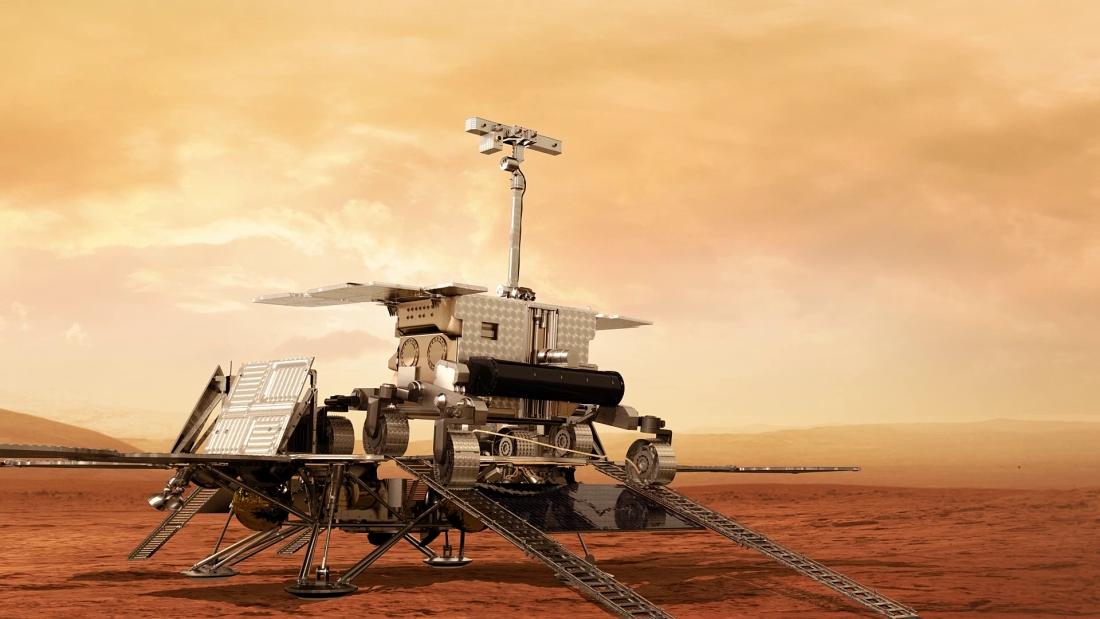A quick chat with the TGO, from the orbit of Mars
“Hi, this is the ExoMars orbiter. How are you doing down there?”
If you’re a space fan, you may know that it’s the Trace Gas Orbiter from the 2016 ExoMars mission talking here. Since then, the spacecraft has been in a circular 400 km orbit around Mars, with all instruments operating as expected and meeting all of its scientific objectives.
In addition to studying trace gases in the Martian atmosphere, of biological or geological origin, the TGO also acts as a data relay for communications from the ExoMars 2020 rover and surface science platform, as well as from rovers deployed by partner agencies.
The TGO's instruments include: Atmospheric Chemistry Suite (ACS); Color and Stereo Surface Imaging System (CaSSIS); Fine Resolution Epithermal Neutron Detector (FREND); Nadir and Occultation for Mars Discovery (NOMAD).

© Thales Alenia Space/Imag[IN]
The TGO is already being used to relay more than 50% of the data from two American missions to Mars, Curiosity and Insight.
The TGO has performed about 200 overflights of the red planet, picking up more than 90 Gb of data from NASA’s Curiosity lander. It was also called on in recent efforts to restore communications with Opportunity, the 14-year-old lander that lost connections during a Martian dust storm in the summer of 2018. Despite these efforts, it was officially declared inactive on February 14, 2019, after traveling 45.16 kilometers during 5111 sols.
The dust storm also affected the TGO’s science observations. Because of the opaque Martian atmosphere, the high-resolution pictures of the surface taken by the CASSIS instrument had to be suspended.
All instruments are up and running again, as the Martian sky is once again clear, promising beautiful new pictures of Mars.
Nor has the TGO stood still. The ESA control team at ESOC identified certain areas for improvement, asking Thales Alenia Space, prime contractor of the ExoMars 2016 and 2020 missions, to make software changes. These modifications will help optimize all communications, especially when the TGO/ground link starts to be critical due to the long distance from the Earth.

© ESA/ATG medialab
On August 28, Mars and Earth will be at the greatest distance from each other, at 400,224,357 km (2.67 AU) and communications will be temporarily interrupted, until the angle between the Earth, the Sun and the spacecraft is greater than 3 degrees. As we get closer to this date, the TGO/Earth data downlink rate will be reduced to 26 kbps, which in turn increases the time needed to download a minimum data set. However the improvements made will guarantee basic communications, despite these conditions.
The TGO’s role will become even more critical once the rover reaches the Red Planet, because all communications with the Rover Operational Control Center in Altec, at Thales Alenia Space’s Turin plant, will be routed through its instruments.
Fuel consumption on the TGO is as planned with significant contingency margins, and few orbit adjustments will be needed to prepare for mission tracking and arrival in March 2021.

© Thales Alenia Space/Master Image Programmes
The upcoming ExoMars 2020 mission entails sending a landing platform to the surface of Mars, along with a rover. America has already carried out this daunting task several times… now it’s Europe’s turn. The rover will be drilling down up to 2 meters to take and analyze soil samples – and no other robot has ever dug so deep! These samples will then be analyzed in a sophisticated mini-lab, named the Analytical Laboratory Drawer, designed by Thales Alenia Space in Italy with the support of OHB and integrated within the Rover vehicle. The ultimate aim is of course to find any traces early martian life like bacteria, which would finally provide an answer to the existential question from your favorite rock’n’roll spaceman, David Bowie: “Is there Life on Mars?”
Or perhaps it would be more accurate to say, “Are there traces of past life on Mars?” That is the question!

© Thales Alenia Space/Master Image Programmes
* ExoMars is an exploration program conducted by the European Space Agency (ESA ) in cooperation with the Russian space agency Roscosmos, designed to study the Martian environment, atmosphere and soil. It will generate huge volumes of data to feed scientific research for many years to come. Thales Alenia Space is prime contractor on both ExoMars missions, 2016 and 2020, at the head of a large industrial consortium. For the 2020 mission, Leonardo will provide the soil sample drill, OHB the carrier module and various rover instruments, while the rover, named after Rosalind Franklin, is supplied by Airbus Defense & Space. NPO Lavochkin will build the descent module and its landing platform.